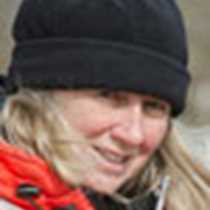Engelsbutka, Spitsbergen & at Sea
Images flashed across the screen and our minds were drawn to the event or day captured in photos by our shipmates. As we synthesize our experiences we discover that our week in Svalbard was really much more than polar bears. It may have been that charismatic creature that drew us to explore but the Arctic has worked its magic and crept into our soul.
Many days begin the same with the land a panoramic scene squeezed between a heavy sky and a frothy sea. But what comes next is always a surprise. Two glaciers flowed towards the sea, both falling short, each having a terminus resting upon the land. No longer does the ocean pluck at their toes and now the edges thin. Their names are so mysterious. The appellations Comfortlessbreen and Uversbreen, the bad weather glacier, seem to indicate that the English whalers working here centuries ago were unhappy with their plight. We, on the other hand, were delighted by the richness found on shore. Rivulets burbled from on high creating meandering gravel highways drawing us further from shore. Between them the land was carpeted by a riot of diversity. Purple saxifrage and pink moss campion clustered in colorful mounds while tiny crenulated leaves of mountain avens stretched out in dense mats. Here and there yellow whitlow grass added a spot of mustard color and if one looked very closely tiny catkins of arctic willow could be found along with a myriad of other botanical wonders. The land was surprisingly soft underfoot, cushioned by mosses but somewhat fluctuant for the tundra was thawing, water accumulating on the still rock hard permafrost. Here and there patterns like ropy lava were drawn as the sodden soil crept slowly downhill on its icy bed beneath. Reindeer grazed happily, nibbling wood rush, grasses, and whatever else they came upon. Around us sharp mountain peaks stretched skyward, sculpted by glaciers and adorned with snow. As the clouds drifted away the azure sky was reflected in the still waters of Engelsbutka (English Bay).
It was our last landing. Boots were packed and belongings were sorted. But the activity did not end for the ship carried us once again to that great underwater ridge known as the “drop-off.” Cold currents from the deep are forced upwards by the slope carrying nutrients for a whole chain of life. Kittiwakes and fulmars swirled about and all around giant plumes of whale blows could be found. Fin whales came and went, their sleek dark backs glistening in the light. It seemed somehow fitting that just as we turned away and set our course to shore, a blue whale waved goodbye. Was this the same individual that had greeted us in the same manner on our arrival? How many people can say they saw the raised flukes of the largest mammal on the planet?
Our week draws to an end. We leave with an experience unexpected. We leave with polar fever and many know they must return once more.




